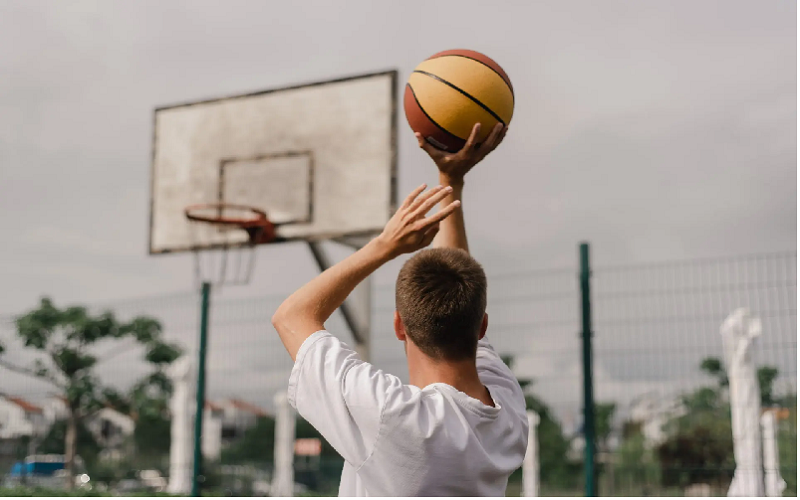
Whether you’re a beginner or an experienced basketball player, developing a consistent shooting routine is the key to improving your game. Tracking your progress allows you to pinpoint strengths and weaknesses, giving you the insights necessary for steady improvement. Creating a shooting drill program and using technology like basketball shot returners, ball machines, and passing machines can take your training to the next level.
Here’s a step-by-step guide on how to build the best shooting drill for basketball and ensure you stay on track.
Track Your Progress with this Shooting Drill Program
1. Set Clear Goals for Your Shooting Drills
Before diving into drills, it’s essential to establish clear goals. Whether you want to improve your three-point shooting, develop a quicker release, or enhance accuracy under pressure, your goals should be specific, measurable, and realistic.
Ask yourself:
- How many shots do you aim to take daily or weekly?
- Are you looking to enhance your shooting percentage from a particular spot?
- Do you want to improve your shooting off the dribble or catch?
Setting these goals will give you a clear direction and motivate you throughout your training program. Make sure to note your goals so that you can track your progress effectively.
2. Choose the Best Shooting Drills for Basketball
Once you’ve established your goals, it’s time to select drills that will address specific areas of your game. Some of the best shooting drills for basketball players focus on different aspects like footwork, shooting form, and timing. Here are a few drills that should be part of your program:
- Spot Shooting: This drill allows you to work on shooting accuracy from various spots on the court. Start by setting up five different shooting positions (such as the corners, wings, and top of the key) and take a set number of shots from each spot.
- Catch-and-Shoot Drill: Focus on improving your release time and accuracy by practicing catching the ball and shooting immediately. This drill is especially effective with a basketball passing machine, which can feed you the ball at game-like speed.
- Dribble Pull-Up Drill: Improve your ability to shoot off the dribble by performing this drill. Dribble toward the basket and take a shot after one or two quick moves. This helps to enhance your in-game shooting abilities and builds confidence in motion.
These drills will help you develop consistency, which is vital when tracking progress.
3. Incorporate Basketball Shot Returners and Machines
One of the most efficient ways to track progress while enhancing the quality of your shooting drills is by using modern training equipment like a basketball shot returner or a ball machine basketball setup. These tools not only save time but also increase the number of shots you can take during each session.
A basketball return system quickly rebounds your shots, allowing you to take more shots without chasing after the ball. More repetitions mean more data points for tracking progress and less wasted time.
A ball machine basketball setup can simulate game-like passes, delivering the ball at different speeds and angles. This helps you practice both shooting and receiving in real game scenarios, while also ensuring you get consistent and measurable repetitions.
4. Create a Schedule and Stick to It
Consistency is key when it comes to tracking progress in your shooting drills. Develop a routine that includes how often you’ll train, how long each session will be, and which drills to include on specific days. Your program could look something like this:
- Day #1: Focus on catch-and-shoot drills with a Basketball Shooting Machine. Aim for 200 shots.
- Day #2: Work on spot shooting and use a basketball shot returner to get 300 shots from different spots.
- Day #3: Practice dribble pull-up drills, working on shooting off movement.
By following a well-structured schedule, you will accumulate enough data to monitor your improvement over time. Make sure to keep a shooting log of your attempts and makes for each drill.
5. Track Your Progress and Adjust Accordingly
Tracking progress is crucial for evaluating how well your shooting drill program is working. A good rule of thumb is to keep track of your shooting percentages, the number of shots made, and areas where you struggle. For example, you might notice your percentage is higher on catch-and-shoot attempts than off-the-dribble shots.
Use a combination of manual tracking (writing down your stats after each session) and tech-based tracking if available. Many basketball return systems and ball machines now come with features that track your shots, providing immediate feedback on your performance.
6. Evaluate and Adjust Your Program
Once you’ve tracked your shooting data over a period of time, take the time to review your progress. Are you improving in the areas you targeted? Are there any drills that aren’t yielding the desired results? Adjust your shooting drill program accordingly. If you’re struggling with a particular aspect, like dribbling into shots, increase the frequency of dribble pull-up drills in your routine.
Remember, it’s essential to keep challenging yourself by adding more difficult drills or adjusting goals. For example, if you consistently make 70% of your shots from the top of the key, increase your target to 75% or extend your shooting range.
Conclusion
Creating and tracking a shooting drill program is an excellent way to improve your basketball skills and stay motivated. By setting clear goals, incorporating the best shooting drills for basketball, using advanced tools like a basketball shot returner or ball machine basketball, and diligently tracking your progress, you’ll see steady improvement over time. Stick to your plan, adjust when needed, and watch your shooting percentage soar.

